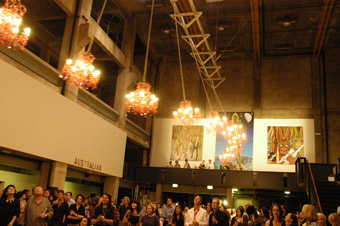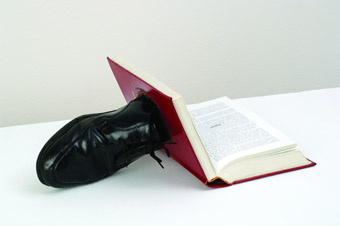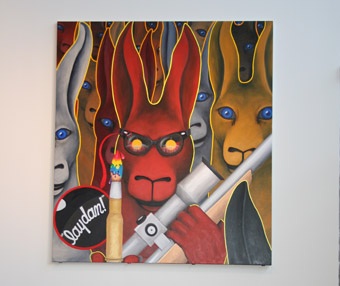entwining china & australia
jacqueline millner in campbelltown and casula

Casula Powerhouse Opening with Suzann Victor’s Contours of a Rich Manoeuvre III
photo Joanne Saad
Casula Powerhouse Opening with Suzann Victor’s Contours of a Rich Manoeuvre III
DESPITE THE FACT THAT ONE FEATURES A SINGLE CHINESE ARTIST, BOTH EXHIBITIONS, AI WEIWEI: UNDER CONSTRUCTION AT CAMPBELLTOWN ARTS CENTRE AND AUSTRALIAN AT CASULA POWERHOUSE, FOREGROUND THEIR SPECIFIC LOCATION IN WESTERN SYDNEY, WITH ITS ASSOCIATIONS OF MULTI-ETHNIC COMMUNITIES, RELATIVE SOCIAL DISADVANTAGE AND REAL VULNERABILITY TO THE ABSTRACT TRANSACTIONS OF GLOBAL CAPITAL. IN HER INTRODUCTION TO THE CATALOGUE FOR UNDER CONSTRUCTION, THE CENTRE’S DIRECTOR LISA HAVILAH DESCRIBES HOW THE PROJECT WAS HATCHED IN THE CONTEXT OF CAMPBELLTOWN’S INTEGRATION INTO SYDNEY’S HEADLINE ACT OF CONTEMPORARY ART, THE BIENNALE, TWO YEARS PRIOR, AND THE CURATOR CHARLES MEREWETHER’S INTEREST IN ENGAGING THE COMMUNITIES OF WESTERN SYDNEY.
Ai Weiwei’s thematic concern with the effects of a rapidly modernising China, including his own role as a collaborator on many significant building projects, is thus woven back into local issues. Not only is Australia’s current prosperity linked largely to China’s demand for raw materials to feed its modernisation, but also the changes such massive development has wrought on the world’s economic balance of power have direct knock on effects for Australian communities, as much as for Australian values, including commitments to heritage, environmental conservation and sustainability.
Over at the recently re-opened and refurbished Casula Powerhouse, ex-Artspace director Nicolas Tsoutas also cites the demographics of the region as a major consideration in putting together the exhibition titled Australian. Along with a number of alumni from the recently dismantled visual arts course at University of Western Sydney (and some current art world stars), the exhibition includes the work of young local artist Sadar Sinjawi, who settled in Casula from Kurdistan. Tsoutas, like Havilah, claims that the particular social and economic pressures in the local area (Liverpool has one of the country’s highest rates of forced mortgagee sales), shadow the work created for the show. While not all the artists consider themselves ‘political’, their work resonates with these broader social phenomena. Commissioned under a curatorial rubric—the complexity of what it means to be Australian today—the work addresses themes such as the environmental impact of exotic species, street culture, the status of national icons, spirituality, migration, Indigenous politics and cross-cultural identity, all permeated by the language of globalisation.

Ai Weiwei, Untitled, 1986, book with shoe,
courtesy the artist and Galerie Urs Meile, Beijing-Lucerne
Ai Weiwei, Untitled, 1986, book with shoe,
Which brings us back to Ai Weiwei’s overarching theme: the price and effect of a China gone global. Ai Weiwei’s work is unnerving in its ability to evoke China’s massive scale, in terms of territory and population, while figuring very few people. The masses are mostly conjured in absentia, through images of traffic, endless housing developments, left luggage or a veritable army of empty chairs. This absence keys in to the predominant aesthetic of the artist’s work in this exhibition: minimalism. Whether in his objects, installations or photographs, Ai Weiwei draws on the language of minimalism, more overtly at times, with his cubes and floor pieces that look to Robert Morris and Carl Andre (such as A Ton of Tea 2006, and Souvenir from Beijing, 2002), more subtly at others. One curious effect of this is that the China he presents is muted, quiet, and formally ordered, not a chaotic and dynamic powerhouse of industry and ideas.
The other effect is that Ai Weiwei’s China appears to be already framed by a Western eye. Certainly his work squarely addresses the history of Western art. One room is dedicated to early pieces from the mid-1980s made while living in New York which pay homage to Marcel Duchamp, Andy Warhol and Joseph Beuys in turn; another work renders Tatlin’s Monument to the Third International as a floating chandelier. His photographic and video documentation of Beijing’s Olympic makeover, and his ‘up yours’ gesture to symbols of global power (such as Study in perspective—White House, 1999), also betray the mediation of a Western eye. It is where this familiarity is less evident, such as in those objects assembled from the detritus of ancient temples destroyed by the forces of modernisation, that the work really bites. The resonance of these ancient relics is very strong; they evoke the irredeemable loss of the past and cultural heritage, and the ruthlessness of progress at any cost. Bed (2004) a floor sculpture made by laying together grooved ironwood recovered from a dismantled Qing dynasty (1644-1911) temple, is particularly poignant. But Ai Weiwei’s hybrid sculptures also exude the spirit of invention and resourcefulness of a nation so spoilt for cultural riches it can afford to squander them. Table with Two Legs on the Wall with Different Angles (2004) and Tables at Right Angles (1998), both made from Qing dynasty furniture, playfully enact cultural contortions while retaining a melancholy air about the indignities of having to perform to a foreign audience.

Gordon Hookey, Deneo C The Verry Verry Really Deadly Divine Sublime Bitchewmen Bhharbee Blhhaktjinn 2008
photo Joanne Saad
Gordon Hookey, Deneo C The Verry Verry Really Deadly Divine Sublime Bitchewmen Bhharbee Blhhaktjinn 2008
The documentary style and austere aesthetics of Under Construction stand in stark contrast to the riotous colour and almost Baroque aesthetics of Australian. Such exuberance is still rare in contemporary Australian art, and makes for a welcome change. Gordon Hookey’s gaudy, deliberately cack-handed comic satires of contemporary Australian politics dominate the main exhibition space at either end. David Griggs’ garishly coloured billboard-like paintings of life lived tough in the Philippines, Savanhdary Vongpoothorn’s intricate perforated canvases and Guan Wei’s multi-panel constellation painting all grapple with Judy Watson’s permanent floor installation and the space’s awkward architecture. Tucked away behind the main room, the lush aesthetics continue in Shaun Gladwell’s video installation, Planet and Stars Sequence, Maria Fernanda Cardoso’s wearable sculptures, Emu Wear, and the latest incarnation of Nike Savvas’ vibrating atom installation, Where Painting Begins: Atomic in full sunlight.
Gladwell’s videos record the artist in four different cities, street busking with his aerosol can. He makes small works on cardboard featuring images of stars and planets, using the containers of everyday multinational products for masking, and then erases each with black paint. It is a simple gesture that effortlessly connects the trajectories of global commodities with the art object, and links the artist’s process with an attempt to claim and control a creative space outside those trajectories. The work is greatly enhanced by its installation in a claustrophobic dead-end of the gallery, under a rail-track whose pylons sport readymade graffiti.
Another work whose installation makes great use of the Powerhouse’s industrial scale and readymade environment (including its permanent installations) is arguably the strongest here: Suzann Victor’s Contours of a Rich Manoeuvre III, a kinetic sculpture suspended above the gallery’s main room, comprising 12 red crystal chandeliers attached to a metal rod. From a motionless start, the pendulums begin to swing and gradually form a pattern: alternate chandeliers cut through the air with great pace and precision, resembling the goosestep of Chinese soldiers. As the movement slows, a new pattern emerges: the chandeliers form a sinuous line that recalls the trail of a Chinese dragon. (Its reflection in Judy Watson’s floor work caused Gordon Hookey to remark that the Rainbow Serpent had been woken!) This is a beautiful work in every sense: an elegant design, a memorable image, an affecting conceptual thread about the choreographed movements that those caught between cultures—in this instance Western and Eastern— must perform.
In probably unintended ways, these two exhibitions complement each other, offering alternative perspectives on the place of the artist in a globalised world, and alternative artistic strategies to engage with the effects of that globalisation.
Ai Weiwei, Under Construction, curator Charles Merewether, Campbelltown Arts Centre and Sherman Contemporary Art Foundation, Campbelltown Arts Centre, May 1-July 26; Australian, curator Nick Tsoutas, new work from 12 artists, Maria Fernanda Cardoso collaborating with Ross Harley, Sean Cordeiro/Claire Healy, Shaun Gladwell, David Griggs, Gordon Hookey, Dani Marti, Raquel Ormella, Nike Savvas and Stephen Little, Sadar Sinjawi, Suzann Victor, Savanhdary Vongpoothorn collaborating with Richard Johnson, Casula Powerhouse, Casula, Sydney, April 5-Sept 7
RealTime issue #85 June-July 2008 pg. 4-5






